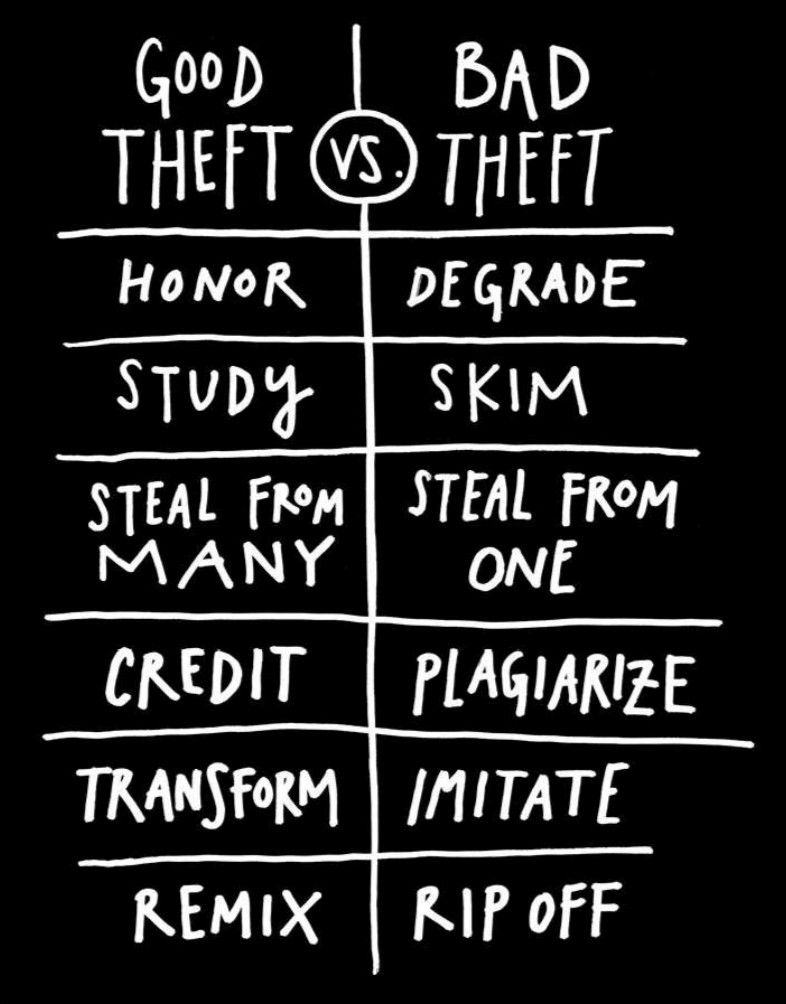“Books are made out of books”, I read this quote by Cormac McCarthy in the book Steal Like an Artist by Austin Kleon. And I can’t decide if it’s an ugly fact, as McCarthy thinks of it, or if it’s actually a beautiful thing that makes us stress less about the dilemma of originality in art, the way Kleon thinks.
Back to our sheep: how do paintings exist?
Paintings exist because paintings have always existed! When an artist is painting, painting ideas and inspirations keep flowing. If you don’t agree with me, how many times have you started a painting that led you to start another painting and ended with a series of unfinished artworks? Those are all paintings made out of paintings.
How many times have you looked at a painting and felt the desire to create one yourself? Like “Yeah, I can create an artwork like this one too”.
No art is original; all art is made out of other art! An author who doesn’t read can’t write. And an artist who doesn’t get visual nutrition can’t paint.
This takes us back to a theory that I shared in 12 Creativity Killers You Want to Avoid Today, which basically states that creativity isn’t innate; creativity is the byproduct of two ideas coming together in our brain and producing a personalized association of both (a child whose parents are two already existing ideas if you will). Our brains don’t create out of nothing; they process data and recreate new associations from existing ones we feed them. And that leads us to question the originality of art.
The Dilemma of Originality in Art
It’s 2023; everything has been done and said before!
When I sit down to create something that is unheard of, unique, and proper to me, I realize that everything already exists. I am competing in a market that is saturated. There are billions of artists out there, and no matter how original my idea is, I still feel as if it’s not 100% mine because I have seen the same subjects, same techniques, same creative processes, and other pillars of artwork everywhere.
Do I still call my paintings originals?
Of course, what makes my paintings original is the fact that I created them. If I repaint the Mona Lisa, that painting is still mine. It is up to us as artists to decide if we want to work on the previously treated subjects, follow the creative process of a master we relate to, or completely go on the hunt to find new, big, bright ideas.

To me, originality and creation start from imitation. Humans have imitated God’s creations, they have painted flowers, landscapes, and portraits of other humans in an attempt to recreate and imitate what exists already. The more humans have imitated, they have come to develop new concepts and come out with pieces that were created from many influences, tastes, and personal preferences. Just like Kleon mentions in the book, An artist steals from many, and a thief steals from one.
So, are you a creator or a curator?
You are both. You can’t be a creator if you don’t start curating. As a beginner, as a child, you’re not required to analyze or produce, you are in your input era. The more inputs you have, the better your chance to “create” grows. Your influences, thoughts that you loved from others, and pieces of knowledge will become the inspiration for your work, but it won’t be just that! You will have created work that sucked and collected useful critiques from your audience, friends, family, etc. and you will have your personal experiences as well as thoughts from different sources which will create a unique voice, a voice that is solely yours; Because not only is the human hand incapable of reproducing the exact same copies, but our brains are also incapable of reproducing the exact same data.
What’s the biggest mistake that one could do in the quest of looking for originality?
Losing hunger, curiosity, and the ability to receive knowledge and be influenced by others is the worst you could do in the quest of finding originality. The stiffer your mind is, the less likely you are to innovate, create and develop. You need to keep data coming, for the more data you have, the more associations you can make, and the more creative you grow.
Another mistake is not sharing your art. In my article, Why do you need Pinterest as an artist? I share with you many insights about the pros of sharing your work in the early stages of your career. Whatever you create, make sure you document it and share it. I know the process can be messy, ugly, and not as aesthetically pleasing as the internet makes it seem like, but the best thing about it is that you grow with the guidance of your audience. Your voice is shaped depending on where people are and how people receive you best. You also become able to tell if you are your most creative self as an educator, an aesthete, or for your persona which isn’t something you can wait for to happen.
Conclusion
To sum it up for you, stop stressing about originality in your art as an artist. If you feel like you’re not as creative as you want to be, keep creating and keep sharing your work for people to see and judge. Quantity over quality in beginnings. Keep an open mind, get influenced, and put in as much information as you can get your hands on and your expectations of originality and creativity will work up to your potential. Enjoy creating <3



1 Comment